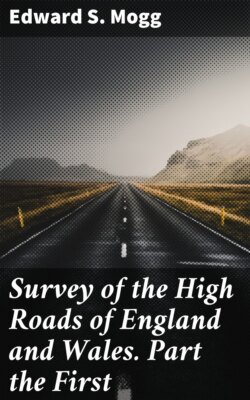Читать книгу Survey of the High Roads of England and Wales. Part the First - Edward S. Mogg - Страница 13
На сайте Литреса книга снята с продажи.
F.
ОглавлениеTable of Contents
Fair Place, 217.
Falmouth, Lord, 179. (see Woolhampton House)
Farnborough Place, 80.
Farnham Castle, 81, the seat of the Bishop of Winchester. The castle is situated on a hill; its shape is quadrangular, built on the site and with part of the materials which composed the ancient castle, destroyed by order of parliament, in the year 1648. It contains a fine library, and some good paintings. The park is of considerable extent, and extremely pleasant.
Felbridge Park, 56.
Fermanagh, Lady, 2. (see May Place)
Fifehead House, 139.
Fitzhugh—— Esq. 220. (see Bannisters Lodge)
Fleming, Col. 212. (see South Stoneham House)
Fleming, Mrs. 79, 211. (see North Stoneham Park)
Flower House, 55.
Flower, Miss, 16.
Fonthill Abbey, 163, the seat of William Beckford, Esq. This magnificent mansion, justly considered unique, whether viewed collectively or in its subdivisions, must, in either case excite astonishment and awaken the most delightful sensations. The house, plantations, extent and variety of this beautiful and diversified spot, individually claim our attention alike, and each merits a particular description, which, to enter upon in a work of so limited a nature as the present, is impossible; we therefore confine ourselves to sketching a few of the most prominent beauties of this justly celebrated and truly magnificent seat.
The enclosures measure about seven miles, surrounded by a stone wall, the internal features of which are diversified with a variety of scenic capabilities, and such has been the taste and judgment exercised in the disposition and arrangement of the embellishments, that a journey of twenty-two miles may be made within these gardens without once retracing the same steps; in the progress of which the scenery will be found equally varied, beautiful, and interesting.
An eminence gradually ascending from the open country on the north is covered with woods, some of which are of ancient growth, but the major part consists of modern plantations, descending to a fine enclosed country to the south. From the apex of a hill, embosomed in this luxuriant grove, rises a mansion called the Abbey, crowned with a lofty tower (visible at the distance of forty miles) turrets, pediments, and pinnacles, bearing every external appearance of an ancient monastic edifice. It is composed of a tower in the centre, 276 feet in height, an entrance hall lofty and spacious, and three wings, extending from the tower to the east, north, and south; the exterior elevation of each of these portions is dissimilar to the others, each appropriated to the purposes of a commodious and elegant mansion; the whole adorned in the most costly manner, and enriched with the choicest productions of the fine arts. The view from the top of the tower is of vast extent, including many counties in its circumference, and embracing a variety of charming scenery interspersed with objects beautifully picturesque. Some conception may be formed of the extent and variety of this scene, when it is known that the tower has its base upon an eminence considerably above the level of the top of Salisbury spire; and in the immediate neighbourhood there is no hill of sufficient magnitude to bound the view. On the summit of a lofty eminence, called The Beacon, is a plain of about six acres, intended for the site of a magnificent tower; the foundations of which are entirely laid, and in most parts the walls are raised to the height of nine or ten feet, it is of considerable extent, in form triangular, with a circular bastion at each of its angles.
From the south-east side, near the foot of this hill, a singularly advantageous prospect of the abbey is obtained. Over a long extent of ground, adorned in the most luxuriant and beautiful manner by trees of various foliage, so arranged as not to interrupt the view, this truly magnificent mansion appears, presenting a grand mass of embattled towers, surmounted by the lofty octagon which composes the centre. This charming scene is backed by an elevated woodland of a sombre aspect, which by contrast heightens the striking and brilliant effect of the edifice, and thus renders complete this unrivalled coup d’œil. Descending into the bottom, a fine lake reflects the beauties of the surrounding scene, which is so arranged as to give an idea of even much greater magnitude than it possesses; it is plentifully supplied with waterfowl. Shooting is not allowed within the enclosure, consequently every animal sports undisturbed, and from their number considerably enliven this enchanting place.
The former mansion at Fonthill, which is now taken down, was situated nearly a mile and a half from the present. Fonthill anciently constituted the lordship of the family of the Giffards, and is still called Fonthill Giffard, to distinguish it from a contiguous parish, denominated Fonthill Bishop.
Foote, R. Esq. 9. (see Charlton Park)
Foreman, W. Esq. 1. (see Westcomb Park)
Fort—— Esq. 209. (see Alderbury House)
Fox Lease, 92.
Freemantle, 91, 220.
Froyle Place, 82.
Fuller—— Esq. 200. (see Neston)
